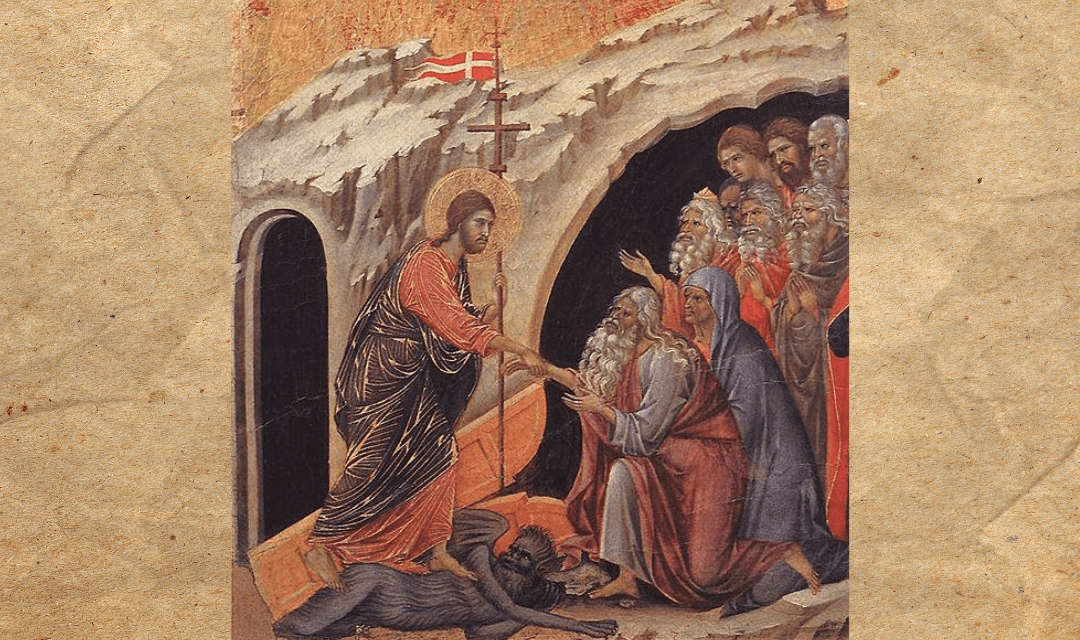This article first appeared in the Christian Research Journal, volume 44, number 4 (2021).
For further information or to support the Christian Research Journal please click here.
When you support the Journal, you join the team and help provide the resources at equip.org that minister to people worldwide. These resources include our ever-growing database of over 2,000 articles, as well as our free Postmodern Realities podcast.
Another way you can support our online articles is by leaving us a tip. A tip is just a small amount, like $3, $5, or $10, which is the cost of a latte, lunch out, or coffee drink. To leave a tip, click here
Where was Jesus between His death and resurrection? Did He really descend into hell, as the Apostles’ Creed states? The Apostles’ Creed is a foundational statement of faith in church history. It not only outlines Christ’s incarnation, suffering, death, resurrection, and ascension, but it also contains the remarkable phrase, “He descended to hell.” Most churches today affirm this creed, yet the clause remains as divisive now as it first did during the Reformation. In thought, worship, and sermons, believers often skip from Christ’s burial to His resurrection, leaving out Holy Saturday. Should this clause be dropped from the creed, or does it faithfully interpret Scripture? Understanding the formation of the Apostles’ Creed, the descent clause, and the history of its interpretation will help readers decide for themselves.
What Is the Apostles’ Creed?
The Apostles’ Creed is one of the oldest Christian statements of faith. Unlike the Nicene Creed or the Chalcedonian Definition, the Apostles’ Creed was not written or approved by an Ecumenical Council; rather, it developed over several hundred years. Its earliest form, the Old Roman Creed, was used liturgically during baptisms and dates back to the second century.1 Its wording remained quite uniform through the fourth century when an almost identical form was documented by the Aquileian priest Tyrannius Rufinus.2 As the Apostles’ Creed gained popularity in the West, it was enhanced with several minor additions until the final version appeared in the early eighth century. This finalized Apostles’ Creed included several new phrases about the Trinity and the church, as well as the controversial statement that Christ “descended to hell.” As noted, most churches today affirm the creed, but the “harrowing of hell” has widely differing interpretations. Eastern Orthodox and Roman Catholics both affirm Christ’s descent to hell, but many Reformed and evangelical Christians deny that such an event occurred. What are the issues that led to these contrasting views?
Hell or Hades?
In the early centuries of the creed, “hell” was synonymous with the Greek Hades and the Hebrew Sheol. In the Old Testament, this place of the dead included both the righteous and the damned. However, following a subsequent linguistic shift, the modern understanding of hell is most synonymous with the Hebrew Gehenna, the area of Sheol that is full of fire, torment, and gnashing of teeth (Matt. 13:42). Therefore, when the Apostles’ Creed states that Christ descended to hell, it is affirming that Christ went to the general place of the dead — both the blessed and the damned.
Early Church Witnesses
The early church generally held that during the three days between His death and resurrection, Christ descended into Hades, freed the righteous dead, and proclaimed His victory over Satan’s bondage (Phil. 2:10). This belief found its source in several New Testament references, including Ephesians 4:9, 1 Peter 3:19, and 1 Peter 4:6, which will later be examined. Though the descent clause was absent from the early versions of the Apostles’ Creed, the belief in the harrowing of hell was widely accepted by most of the early church fathers: Ignatius of Antioch, Polycarp, Justin Martyr, Tertullian, Cyril of Alexandria, Origen, John Chrysostom, Cyril of Jerusalem, Hilary of Poitiers, Ambrose of Milan, and Gregory Nazianzus, among others. For example, Irenaeus of Lyons (c. 130 – c. 202), in Against Heresies, stated, “It was for this reason, too, that the Lord descended into the regions beneath the earth, preaching His advent there also. And He [declared] the remission of sins received by those who believe in Him.”3 Clement of Alexandria (c. 150 – c. 211) wrote in the Stromata, “[Christ] preached the Gospel to those in the flesh so that they would not be condemned unjustly. So how is it conceivable that He did not for the same reason preach the Gospel to those who had departed this life before His coming?”4 Finally, Augustine (354–430) affirms the descent, contending that Jonah’s encounter with the sea monster foretold “that Christ would rise on the third day from the depths of Hades.”5
Not only was there a consensus patrum (consensus of the Fathers) in both the East and the West about Christ’s literal descent to hell, the harrowing of hell seems to have been popular among the laypeople of the church, as can be seen in ancient liturgies, hymnography, and poetry. The Easter troparion, a short hymn that likely was in use by the second century and is still sung in Eastern Orthodox churches today, proclaims Christ’s victory over hell: “Christ is risen from the dead, trampling down death by death, and upon those in the tombs bestowing life.”6 Additionally, a verse from the extensive Paschal hymn of Ephrem the Syrian (c. 306–373) reads: “Death finished his taunting speech and our Lord’s voice rang out thunderously in Sheol, tearing open each grave one by one. Terrible pangs seized hold of Death in Sheol….The dead went forth, and shame covered the living who had hoped they had conquered Him who gives life to all.”7 Belief in the harrowing of hell was clearly widespread in the early church. How, then, did so many churches come to reinterpret the clause metaphorically?
Impact of the Reformation
During the Reformation, the doctrine of Jesus’ descent was one of the foremost Roman Catholic doctrines examined. Interestingly, Martin Luther (1483–1546) affirmed the descent, and it was not until John Calvin (1509–1564) that the clause was questioned. Instead of a literal interpretation, Calvin understood “he descended to hell” metaphorically as a reference to Christ’s substitutionary atonement.8 He believed that the phrase indicated Jesus’ torment as He suffered on the cross and took on the sin of humanity.9 After the Reformation, both Reformed and numerous evangelical churches largely denied a literal interpretation of the descent. Today, many evangelical and Reformed churches interpret the clause as a reemphasis of Christ’s death,10 while other Reformed churches ascribe to Calvin’s view.11
Arguments Against the Descent
Many Reformed and evangelical churches confess that Christ could not have descended to Hades, using both biblical and historical arguments. First, the Bible does not explicitly state that Jesus entered Hades when He died. Ephesians 4:9, 1 Peter 3:19, and 1 Peter 4:6 are not only unclear and open to interpretation, but other Bible verses could be used actually to teach against the descent. For example, when Jesus cried out, “It is finished” (John 19:30),12 Christ’s suffering and separation from the Father were complete. A descent to Hades would only prolong His anguish. Jesus’ exclamation, “Father, into your hands I commit my spirit” (Luke 23:46), is further evidence that His saving work was complete. Where was Christ during the three days, then? His encouragement to the thief on the cross, “Truly I tell you, today you will be with me in paradise” (Luke 23:43), suggests that He immediately went to be with the Father in heaven, as all believers do.13
As for historical evidence against the descent, proponents of this view argue that the Apostles’ Creed was not written by a single church council and, therefore, does not bear the theological weight of an Ecumenical creed. Since the descent clause itself does not appear explicitly until the eighth century, it loses credibility. Additionally, in the fourth century, Rufinus stated in his commentary on the Apostles’ Creed: “‘He descended into hell,’ is not added in the Creed of the Roman Church, neither is it in that of the Oriental Churches. It seems to be implied, however, when it is said that ‘He was buried.’”14 This quote could be used to argue that not only was the clause explicitly absent from many churches, but it was mainly synonymous with Christ’s death and burial. Thus, Christians who advocate for this position often believe the phrase either reflects an ancient fallacy or reemphasizes the Lord’s suffering, death, and burial. Because of the confusion it causes, some argue that “there would be all gain and no loss if [the clause] were dropped from the Creed once for all.”15
Arguments for the Descent
Eastern Orthodox, Roman Catholic, Lutheran, Anglican, and other Christian traditions affirm Christ’s descent to Hades. Biblically speaking, one of the most commonly cited references is 1 Peter 3:19: “After being made alive, [Christ] went and made proclamation to the imprisoned spirits — to those who were disobedient long ago when God waited patiently in the days of Noah while the ark was being built.” Though Augustine argued that this passage in particular was a reference to Christ preaching through Noah to the unbelievers of his time,16 this understanding is questionable in light of the chronological narrative of the context. This text seems to indicate that Christ descended into Hades on Easter Saturday and proclaimed His victory over death and the demonic powers to imprisoned souls. Additionally, given Peter’s solemn warning to the living and the dead in 1 Peter 4:5, it should not be assumed that he moves from the physically dead to the spiritually dead in verse 6. In fact, 1 Peter 4:6 reinforces the descent: “For this is the reason the gospel was preached even to those who are now dead, so that they might be judged according to human standards in regard to the body, but live according to God in regard to the spirit.” Another example is Romans 10:6–7: “But the righteousness based on faith speaks as follows: ‘Do not say in your heart, “Who will go up into heaven?” (that is, to bring Christ down) or “Who will descend into the abyss?” (that is, to bring Christ up from the dead)’” (NASB). Paul here equates the place of the dead to the abyss; thus, it is reasonable to interpret this as not only Christ’s physical resurrection, but also His resurrection from the place of the dead spirits. Finally, Ephesians 4:9 is often interpreted as Jesus’ incarnation: “What does ‘He ascended’ mean except that He also descended to the lower, earthly regions?” However, since the Greco-Roman culture of Paul’s day was teeming with stories of people descending into Hades, it is likely that everyone understood “lower, earthly regions” as the underworld.17 Other descent texts include Matthew 12:40, Matthew 27:51–52, and Acts 2:31.
Additional support for the descent into Hades is found in Scripture’s broader witness. For example, throughout the Old Testament, God’s people often express hope that the Lord will deliver them from the depths of Sheol (Ps. 88:3, 116:3), something they cannot do themselves. Gregory of Nazianzus famously taught that Christ took on the whole of humanity in order to redeem and heal it.18 Why, then, would His victory be revealed only to the living and not to the dead, since believers are united to Jesus in both His life and death (Rom. 6:3–5)?
Moreover, the weight of the ancient church’s witness must be taken into account, given that belief in the descent was nearly universal. Although the commentator Rufinus stated that the descent clause was missing from several churches’ creedal definitions, its absence was not due to their rejection of its teaching. The descent was implicit in the preceding phrase, “He suffered under Pontius Pilate, was crucified, died, and was buried.” In other words, the early church affirmed Christ’s descent by declaring His death and burial, avoiding repetition. As Matthew Emerson has argued, Jesus’ atonement and descent may well have been “part of His exaltation, not His humiliation.”19 The collective patristic, liturgical, and biblical witnesses all point to Christ’s descent.
The theology of Holy Saturday has been debated since the Reformation. Many churches today affirm the descent clause in their recitation of the Apostles’ Creed, while others want to drop it altogether. To be theologically informed, Christians must weigh the biblical, historical, and theological arguments for and against the clause. Regardless of the outcome, however, both sides can rejoice in Christ’s victory over death. In the words of the ancient hymn, “Christ is risen from the dead, trampling down death by death!”
Melanie Nassif holds a BA in theology from Union University and is a candidate for the MA in Theological Studies at Trinity Evangelical Divinity School.
NOTES
- Rufinus of Aquileia, A Commentary on the Apostles’ Creed, trans. J. N. D. Kelly (New York: Newman Press, 1954), 121.
- J. N. D. Kelly, Early Christian Creeds (London: Continuum, 1960), 101.
- Irenaeus, Against Heresies, IV.27.2, in Ante-Nicene Fathers, ed. Alexander Roberts and James Donaldson (Peabody, MA: Hendrickson Publishers, 1995), 1:499.
- Clement of Alexandria, The Stromata, VI.6, in Ante-Nicene Fathers, ed. Alexander Roberts and James Donaldson (Peabody, MA: Hendrickson Publishers, 1995), 2:492.
- Augustine, City of God, XVIII.30, trans. J. W. C. Wand (London: Oxford University Press, 1963), 297.
- Metropolitan Hilarion Alfeyev, Christ the Conquereor of Hell: The Descent into Hades from an Orthodox Perspective (Crestwood, NY: St Vladimir’s Seminary Press, 2009), 34.
- Ephrem of Syria, Der heiligen Ephraem der Syrers Carmina Nisibena, ed. Deborah Beck, CSCO (Louvain, Belgium: Peeters Publishers, 1963), 2:4, quoted in Alfeyev, Christ the Conqueror of Hell, 113.
- Matthew Emerson, “He Descended to the Dead”: An Evangelical Theology of Holy Saturday (Downers Grove, IL: InterVarsity Press, 2019), 92.
- John Calvin, Institutes of the Christian Religion 16.8–12.
- See Westminster Larger Catechism, Q50.
- See Heidelberg Catechism, Q44.
- All Bible quotations are from the New International Version unless otherwise noted.
- Wayne Grudem, Systematic Theology (Grand Rapids, MI: Zondervan 1994), 592.
- Rufinus of Aquileia, A Commentary on the Apostles’ Creed, 52.
- Grudem, Systematic Theology, 594.
- Augustine, Letters 131–164, The Fathers of the Church, trans. Wilfrid Parsons (Washington, D.C.: Catholic University of America Press, 1953), 383.
- Frank S. Thielman, Ephesians, BECNT (Grand Rapids, MI: Baker Academic, 2010), 270.
- Gregory of Nazianzus, “Letter to Cledonius, 101,” in On God and Christ, trans. Lionel Wickham, ed. John Behr (Crestwood, NY: St Vladimir’s Seminary Press, 2002), 158.
- Emerson, He Descended to the Dead,









